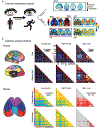Why is everyone talking about brain state?
- PMID: 37164869
- PMCID: PMC10330476
- DOI: 10.1016/j.tins.2023.04.001
Why is everyone talking about brain state?
Abstract
The rapid and coordinated propagation of neural activity across the brain provides the foundation for complex behavior and cognition. Technical advances across neuroscience subfields have advanced understanding of these dynamics, but points of convergence are often obscured by semantic differences, creating silos of subfield-specific findings. In this review we describe how a parsimonious conceptualization of brain state as the fundamental building block of whole-brain activity offers a common framework to relate findings across scales and species. We present examples of the diverse techniques commonly used to study brain states associated with physiology and higher-order cognitive processes, and discuss how integration across them will enable a more comprehensive and mechanistic characterization of the neural dynamics that are crucial to survival but are disrupted in disease.
Keywords: arousal; integrative neuroscience; multiscale analysis; neural dynamics; spontaneous activity.
Copyright © 2023 The Authors. Published by Elsevier Ltd.. All rights reserved.
Conflict of interest statement
Declaration of interests The authors declare no competing interests.
Figures




References
Publication types
MeSH terms
Grants and funding
LinkOut - more resources
Full Text Sources

